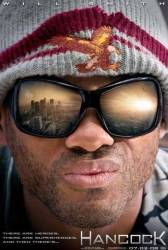Factual error: In the opening chase, Hancock arrives, promptly destroying highway signage that breaks up and collapses. At left on the screen, a large portion of this debris lands on the trunk of a police car, which then defies physics by having its front end (the heavier end) simply rise up off the ground. The car reaches a 45-degree angle, then the rear end leaves the ground as well as the nose lowers again, and the car is momentarily airborne. Nothing falls in front of the car to form a ramp that would send the car upward. The debris would have merely crushed the back of the car and perhaps brought it to an abrupt halt. No lever/fulcrum action would occur as the suspension would collapse first. Nothing like what we see is remotely possible. (00:03:20)
Factual error: Basic physics - Hancock throws Michel from a dead stop to above cloud level in about eleven seconds. The clouds are bog standard cumulus which form at around 7,000 metres in temperate zones. This means that Michel accelerates to about 700 metres per second instantly, from a dead stop. Obviously he cannot accelerate during his ascent, so his starting speed has to be at least that. (In fact he would have to start his ascent much, much faster than 700 metres per second as he would be constantly decelerating due to gravity and air resistance, but it will do as a start point.) Michel accelerates from 0 to 2,520 kilometres per hour - twice the speed of sound - in zero seconds. He would be accelerating at around 5000 Gs, turning him into a very long streak of fine, pink mist.
Factual error: When the police are cowering behind their bullet riddled cars, the metal on the bullet holes is bent inwards as if the shots had come from the other direction.
Factual error: During the bank robbery, Hancock throws a metal lamp shade to sever the leader's hand, who is holding a spring loaded, dead man switch. The switch would have released the instant the hand was severed and the muscles relaxed.
Factual error: When Hancock saves Ray's life by stopping the train, stopping the train instantly like that would have caused it to violently derail, likely killing everyone on the train, and causing massive damage to the entire neighborhood.
Factual error: End of the movie, Hancock is in New York with the sun setting. Ray and family are in L.A. with the moon out and no Sun. New York would have nightfall before L.A. would, considering it's 3 hours behind New York.
Suggested correction: It is nighttime in both locations. In New York, there is a dim glow in the sky due to light pollution. This the same reason it is almost impossible to see any stars in the night sky in New York City. Also, a full moon that far above the horizon is only possible at nighttime, and we see Hancock look up at the moon, so again it is nighttime in NYC.
Factual error: When Hancock is upset that his bottle is smashed, he puts his feet through the bottom of the vehicle, stopping it. In the long shot, the SUV stops slow enough that the occupants would have been pushed forward, not slammed into the windshield.





